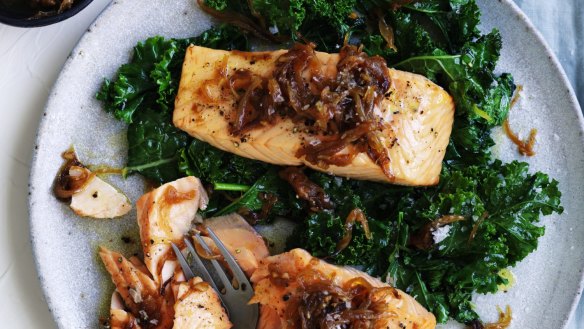The secret to perfect caramelised onions

What's the secret to caramelising onions? P. Redstone
Patience. Patience and vigilance. You also need heat. Heat to get all the chemical reactions going. You need the heat to burst the cell walls and release the liquid inside the cells. You need the heat to get the sugars and proteins and other compounds to recombine into more delicious darker flavour and aromas under what is known as the Maillard reaction. You need the heat to evaporate the liquid. You need the heat to break down the white sugar – we will come to this – into smaller, sweeter sugar molecules. But once those little slivers of onion hit the hot saucepan, they have a propensity to turn very quickly into nasty charred splinters.
So, try this method:
- Take four large onions. Trim, peel and slice in half lengthwise. Cut into very fine lengthwise slices.
- Take a large heavy-based pan and place over medium-high heat. Sprinkle over a tablespoon of sugar. This speeds the caramelisation process. When it has turned to liquid, add the onions. Use a flat wooden spatula and toss the onion through the caramel.
- Add a large teaspoon of salt. The salt draws liquid from the onion and speeds the evaporation. Keep moving the onions around. The Maillard reaction will cause a build-up of darker material on the bottom of the pan. Stirring will stop the onions from catching and then burning.
- Deglaze this build-up with a little water – a few tablespoons plus a little elbow grease. Repeat as necessary.
Depending on the onions, your pot, and your heat source, the process from raw onions to beautiful brown, gooey sweet onions will take about 25 minutes. I love to add a bay leaf to the pot for a deeper flavour if suitable.
Take your time and be vigilant; experiment with your pot and stove, and remember that the amount of water in onions will differ from variety to variety, from season to season.
If a recipe calls for white fish, what sort should I use? P. Humphreys
White fish, or "whitefish", is a northern hemisphere term and refers to cod, haddock, hake, and pollock and other fish generally found on or near the seabed. They are called whitefish because of the pale colour of their flesh. This is opposed to fish with darker coloured muscle such as tuna and mackerel. These are pelagic fish, live in the water column, have red or pink-hued flesh, and are packed with oil – up to 30 per cent oil in their flesh.
Whitefish have little oil in their bodies, except in their livers. This absence of oil means white fish can be salted, dried and preserved without becoming rancid. Think bacalao or smoked cod. They also have a milder flavour. The Sydney Fish Market suggests choosing mild-flavoured fish such as blue-eye trevalla, ling, coral trout, mahi-mahi, and red emperor. If you're cooking a dish in which the fish is going to be chopped or pounded, such as fishcakes, make sure you buy a boneless product. If you're concerned about sustainability, look for the Marine Stewardship Council (MSC) logo, a white fish on a light blue background. Coles and Aldi follow MSC guidelines. Melbourne readers can consider The Fish Shoppe (Collingwood and South Melbourne Market), which stocks only MSC-certified fish.
Send your vexing culinary conundrums to brainfood@richardcornish.com.au or tweet to @realbrainfood.
Appears in these collections
- More:
- Food
- Brain food
